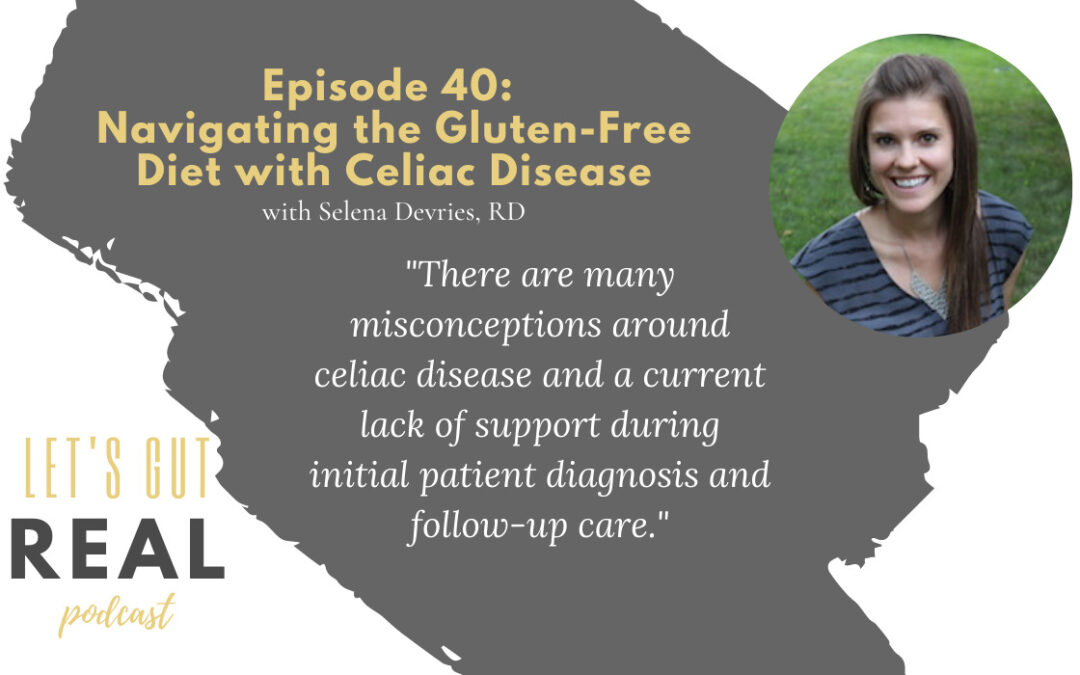The current treatment protocol for celiac disease is to follow a 100% strict gluten-free diet for life. This week I interview RD Selena Devries about different ways to advocate for yourself if you have been diagnosed with celiac disease and helpful ways to encourage your transition into eating gluten-free.
Nutrition Pearls for the Gluten-Free Diet for Patients with Celiac Disease
- Be your own best advocate! Celiac disease is complicated and there is a current lack of treatment awareness among health care provides
- Celiac disease can cause many different symptoms and can impact all organs in the body
- Lack of symptomology can make it challenging to follow the gluten-free diet because there is no feedback mechanism
- Even if you are asymptomatic and you feel fine, it is still important to follow the gluten-free diet
- Understanding cross-contamination and label reading can help patients achieve greater diet adherence
- Be open to learning to cook with new foods and meal planning
- Be aware of the important nutrients of concern for patients with celiac disease
- Look into gluten-free whole grains – these play a huge role in increasing fibre intake
- Know that eating out is likely going to be very difficult but there are solutions!
- Remember to follow up regularly with your doctor or with a registered dietitian
- Print out and bring the “Follow up Care Resource Guide (2016) – for Physicians” from the Canadian Celiac Association website with you to give to your doctor (https://www.celiac.ca)
Were you recently diagnosed with celiac disease? Having celiac disease can mean something different for each patient. There are many different symptoms and yet some people may not experience any symptoms at all.
This week I interview RD Selena Devries about different ways to advocate for yourself if you have been diagnosed with celiac disease and helpful ways to encourage your transition into eating gluten-free.
Selena Devries is a registered dietitian from BC Canada. She completed her dietetic training at Kelowna General Hospital in 2013 and was, shortly, after diagnosed with celiac disease herself. Through her diagnosis, she started to volunteer with the Canadian Celiac Association and ended up working on their national board of directors as well as their professional advisory council with other celiac dietitians and gastroenterologists. She is also trained in the low FODMAP diet for IBS through Monash University. Her own diagnosis and follow up led her to discover gaps in care for celiac disease which led her to private practice with a focus on the dietary management of celiac disease. With her online nutrition practice, she helps celiacs fall back in love with food. She helps them resolve persistent symptoms despite a GF diet, help the newly diagnosed get off on their best foot, and help celiacs eat out with confidence.
We talk about:
- How Selena became interested in celiac disease
- What is celiac disease?
- The common symptoms of celiac disease and some emerging symptoms (GI and otherwise)
- The mainstay in celiac treatment
- What you see as major gaps as a dietitian working with celiac and living with celiac when it comes to celiac education
- High risk gluten-free grains
- Tips for eating out while gluten-free
- What to do when symptoms don’t improve
- How to advocate for yourself as a patient with celiac disease
- Health monitoring protocols like annual blood labs
- The overlap with IBS and SIBO or other gastrointestinal issues
Connect with Selena on her website at Healthbean.ca on Instagram @Celiac_dietitian or on her Twitter here as well!



Recent Comments